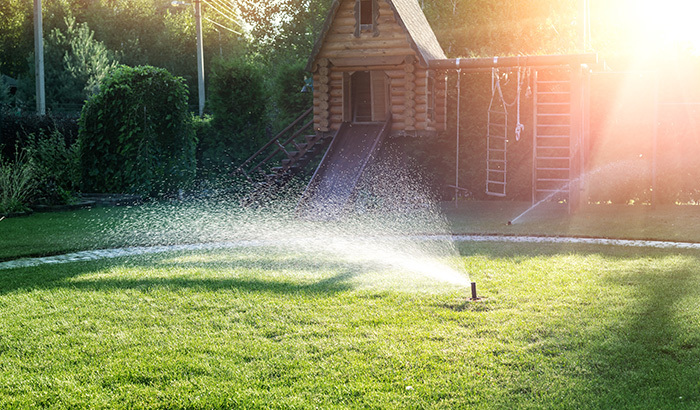Trying to figure out how often to water can be tricky, whether you water your lawn manually or you have a sprinkling system. And just when you think you’ve figured out how much water your grass needs during the spring, the heat of the summer arrives and changes everything you thought you knew about keeping your lawn green. Add in a crippling drought with its accompanying watering restrictions, and it might feel like you’re starting at square one.
Every lawn is different and has unique needs. But here’s a look at how often you should water your lawn in Utah, how long each zone should run, and what to do when your grass isn’t looking so good.
Utah’s Drought
The state of Utah is experiencing an extreme drought, and many cities have implemented watering restrictions to conserve water. You can check this guide from the Utah Department of Natural Resources for current watering guidelines across the state. Here are some additional tips that can help you conserve water while keeping your lawn healthy:
- Avoid watering while it’s windy. This leads to water blowing in unnecessary areas and evaporating more quickly.
- Water at night or in the early morning when more water will seep into your grasses roots and less water will evaporate from the heat and the sun.
- Raise your mower to keep your grass a little longer. Longer grass will shade the roots and hold moisture in for longer.
- Let the rain count as a watering day, and don’t water for at least two days after a rainstorm.
The rest of this guide will address how often you should water your lawn under ideal circumstances when a drought and water restrictions aren’t a concern.
Watering Your Lawn in The Summer
Summer temperatures in Utah frequently reach over 90 degrees, and sometimes even higher. This kind of heat can cause lawns to dry up quickly, so frequent watering is important. Here are some key points for how often and how long to water your grass when the temperatures exceed 90 degrees on a daily basis.
- Water three to four times per week. Lower temperatures in the spring and fall mean you can water less frequently, but the heat of the summer calls for more frequent watering.
- Run sprinklers for 30-60 minutes per zone. The proper amount of time you should be watering each zone will depend on what type of sprinklers you have and how much water pressure you’re getting. The goal is to get at least half an inch of water onto the grass each time you run your sprinklers. This will take longer if you hand water or have long-distance rotary sprinkler heads. Fan-style pop-up sprinkler heads typically water faster and don’t need to run as long to reach the half-inch goal.
- Hand water dry areas. Even well-installed sprinkler systems are likely to leave dry spots, so you should expect to hand water the areas of your lawn that don’t get as much water from the sprinklers. These areas will become evident a few weeks into the summer heat. You can identify them by looking for dry, yellowing spots that don’t grow as quickly as the other areas of your lawn.
Many people try to increase their watering time and frequency to address dry areas, but this isn’t the best option. It can lead to overwatering some areas and wasting water while still not allowing enough water to reach the dry areas. Hand watering is a much better option.
Signs You Need to Water More
It can be difficult to know if you’re watering your lawn enough until it’s too late. It takes time to correct a dry lawn, so identifying that your grass needs more water early on can help keep it healthy and dry. Watch out for these signs that your lawn needs more water:
- Your grass remains flat after you walk on it. Healthy grass that’s got enough water will spring right back into place after being pushed flat. Dry grass will stay matted down.
- The soil underneath your lawn is dry and dusty. Soil should remain moist at all times in order to keep your grass at its healthiest.
- The grass has a bluish or grey tint to it. If it’s not bright green, it probably needs more water.
- Your grass blades are looking like pointy needles with a vein down the middle. They might even fold in half. Healthy grass blades are flat and wide.
Watering Sod
New sod has different water requirements since it dries out extra quickly. Sod should be watered daily until the roots are established and can reach deep into the soil for extra moisture. This process usually takes about two weeks. At this point, you can water the sod as you would an already established lawn.
Is Your Lawn Struggling? Monarch Sod Is Here To Help
Figuring out how often to water your lawn can be challenging, especially during periods of drought. So if your grass is struggling, Monarch Sod is here to help. Our team of lawn experts can help you maintain your summer lawn so you have a beautiful place to play games, host company, and spend quality time together.
Our team at Monarch Sod knows that every lawn is different and has unique needs. That’s why we’re here to install beautiful sod for you to enjoy for years to come. We’ll teach you how to care for your lawn and can even give advice on keeping your grass healthy while dealing with water restrictions.
Monarch Sod is located in Lehi, Utah, and knows how to care for Utah soil. You can trust us with your lawn care needs! We serve all of the cities in Utah and Salt Lake counties, so be sure to reach out to us for your summer lawn care needs. You can call us at 801.701.8633 or email us at info@monarchsod.com. We look forward to helping you keep your summer lawn healthy!
toto slot










